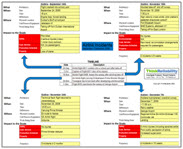In our previous blog about Flight 188 of Northwest Airlines, we discussed the first step of a root cause analysis investigation – defining the problem – and mentioned that a detailed Cause Map could be developed when more information regarding the incident was released.
 The National Transportation Safety Board (NTSB) has recently released a report on what exactly happened to the flight. We can build off of the outline we already developed to put together the Cause Map, or visual root cause analysis.
The National Transportation Safety Board (NTSB) has recently released a report on what exactly happened to the flight. We can build off of the outline we already developed to put together the Cause Map, or visual root cause analysis.
First we begin with the impacts to the goals. Most importantly, the safety and property goals were impacted due to the potential danger to the flight. This was caused by the plane overshooting the destination. The pilots flew over the destination because they were distracted, warnings were not effectively delivered to them, and they couldn’t see their destination (Minneapolis-St. Paul), since it was after dark and cloudy.
The pilots were distracted by a non-operation activity. The two pilots were utilizing the scheduling software on their laptops, both of which were open in the cockpit (possibly blocking some of the flight display). Both using personal laptops and participating in non-operational activities is prohibited by the airline.
Some may ask how it’s possible that two pilots who were flying a plane – with over a hundred passengers – could be spending all their energy on another activity. Well, the pilots did not actually have any active tasks to fly the plane. The plane was on auto-pilot, and the one task that pilots ordinarily did on a regular basis (which would have certainly alerted the pilots to their position) was sending a position report. However, a dispatcher for the airliner had asked the pilots NOT to send a report, as the reports were burdensome and unneccessary.
Warnings did not effectively get through to the pilots by sight – either the flight display was physically blocked by the laptop or the pilots weren’t looking at it because they were distracted – or sound – the plane was not equipped to send audible message (such as chimes or buzzers) to the pilots, text messages sent to them were not acknowledged, and the pilots did not hear calls for them on the radio. The air traffic controllers (who were different from the air traffic controllers who had first had contact with the plane) did not know which frequency the plane was on, so only some messages got through. Because the pilots were using the speaker instead of headsets and were, again, distracted, they missed the messages.
Both of the pilots involved had their licenses revoked. Several procedures were not followed in this instance, and the FAA and individual airlines are working on highlighting the importance of these procedures. Reading about this incident (and seeing that the pilots’ license were revoked) will probably do much to highlight the importance of the procedures. Luckily, nobody was hurt for this lesson to be learned.
View the root cause analysis investigation by clicking “Download PDF” above.


